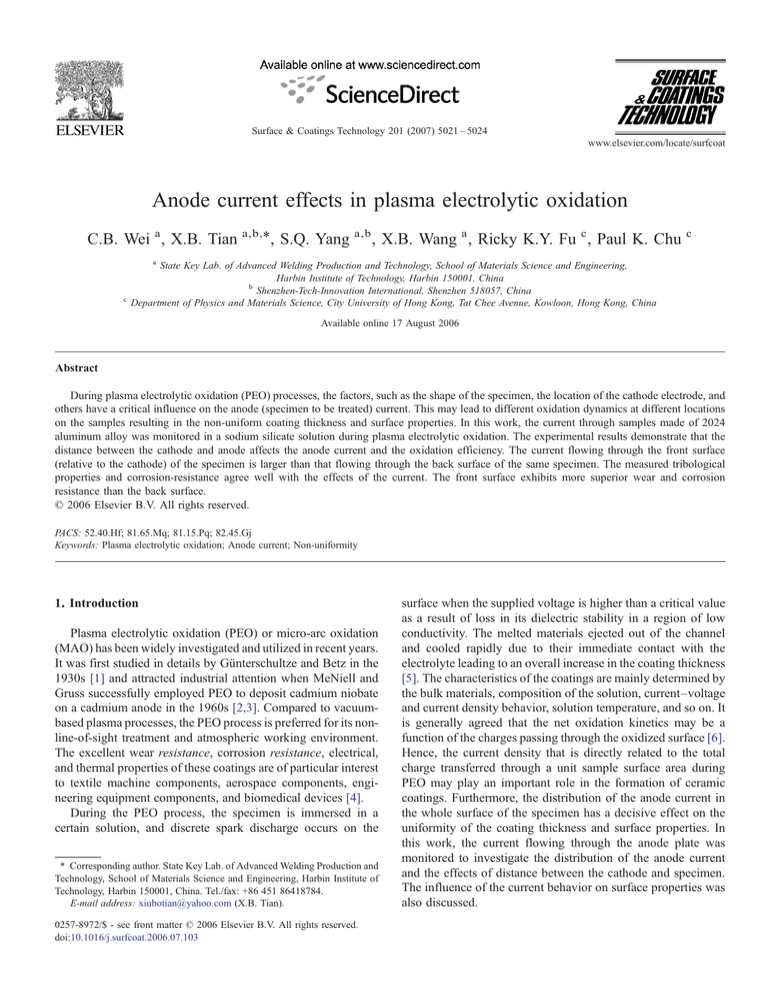
Surface & Coatings Technology 201 (2007) 5021 – 5024
www.elsevier.com/locate/surfcoat
Anode current effects in plasma electrolytic oxidation
C.B. Wei a , X.B. Tian a,b,⁎, S.Q. Yang a,b , X.B. Wang a , Ricky K.Y. Fu c , Paul K. Chu c
a
c
State Key Lab. of Advanced Welding Production and Technology, School of Materials Science and Engineering,
Harbin Institute of Technology, Harbin 150001, China
b
Shenzhen-Tech-Innovation International, Shenzhen 518057, China
Department of Physics and Materials Science, City University of Hong Kong, Tat Chee Avenue, Kowloon, Hong Kong, China
Available online 17 August 2006
Abstract
During plasma electrolytic oxidation (PEO) processes, the factors, such as the shape of the specimen, the location of the cathode electrode, and
others have a critical influence on the anode (specimen to be treated) current. This may lead to different oxidation dynamics at different locations
on the samples resulting in the non-uniform coating thickness and surface properties. In this work, the current through samples made of 2024
aluminum alloy was monitored in a sodium silicate solution during plasma electrolytic oxidation. The experimental results demonstrate that the
distance between the cathode and anode affects the anode current and the oxidation efficiency. The current flowing through the front surface
(relative to the cathode) of the specimen is larger than that flowing through the back surface of the same specimen. The measured tribological
properties and corrosion-resistance agree well with the effects of the current. The front surface exhibits more superior wear and corrosion
resistance than the back surface.
© 2006 Elsevier B.V. All rights reserved.
PACS: 52.40.Hf; 81.65.Mq; 81.15.Pq; 82.45.Gj
Keywords: Plasma electrolytic oxidation; Anode current; Non-uniformity
1. Introduction
Plasma electrolytic oxidation (PEO) or micro-arc oxidation
(MAO) has been widely investigated and utilized in recent years.
It was first studied in details by Günterschultze and Betz in the
1930s [1] and attracted industrial attention when MeNiell and
Gruss successfully employed PEO to deposit cadmium niobate
on a cadmium anode in the 1960s [2,3]. Compared to vacuumbased plasma processes, the PEO process is preferred for its nonline-of-sight treatment and atmospheric working environment.
The excellent wear resistance, corrosion resistance, electrical,
and thermal properties of these coatings are of particular interest
to textile machine components, aerospace components, engineering equipment components, and biomedical devices [4].
During the PEO process, the specimen is immersed in a
certain solution, and discrete spark discharge occurs on the
⁎ Corresponding author. State Key Lab. of Advanced Welding Production and
Technology, School of Materials Science and Engineering, Harbin Institute of
Technology, Harbin 150001, China. Tel./fax: +86 451 86418784.
E-mail address: xiubotian@yahoo.com (X.B. Tian).
0257-8972/$ - see front matter © 2006 Elsevier B.V. All rights reserved.
doi:10.1016/j.surfcoat.2006.07.103
surface when the supplied voltage is higher than a critical value
as a result of loss in its dielectric stability in a region of low
conductivity. The melted materials ejected out of the channel
and cooled rapidly due to their immediate contact with the
electrolyte leading to an overall increase in the coating thickness
[5]. The characteristics of the coatings are mainly determined by
the bulk materials, composition of the solution, current–voltage
and current density behavior, solution temperature, and so on. It
is generally agreed that the net oxidation kinetics may be a
function of the charges passing through the oxidized surface [6].
Hence, the current density that is directly related to the total
charge transferred through a unit sample surface area during
PEO may play an important role in the formation of ceramic
coatings. Furthermore, the distribution of the anode current in
the whole surface of the specimen has a decisive effect on the
uniformity of the coating thickness and surface properties. In
this work, the current flowing through the anode plate was
monitored to investigate the distribution of the anode current
and the effects of distance between the cathode and specimen.
The influence of the current behavior on surface properties was
also discussed.
5022
C.B. Wei et al. / Surface & Coatings Technology 201 (2007) 5021–5024
2. Experimental details
A 2024 Al-alloy plate was used as the anode electrode and
the cathode was a 304 stainless steel plate. The composition of
the aluminum plate is 3.8–4.9% Cu, 1.2–1.8% Mg, 0.3–0.9%
Mn, ≤ 0.50% Fe, ≤ 0.50% Si, ≤0.30% Zn, ≤ 0.10% Ni,
≤ 0.15% Ti, ≤0.50% Fe + Ni and the balance being Al. The
aluminum alloy plate (150 mm × 70 mm × 2 mm) was grounded
with 800-grit diamond paper before PEO. The PEO experiments
were performed using a homemade pulsed DC power supply.
The schematic diagram of the PEO system is shown in the
Fig. 1. The anode and cathode plates were located face to face
separated by a distance of 5, 10, 15, 20, or 25 cm. The
electrolyte was made of sodium silicate in distilled water with
other additives. The anode current waveform was monitored
using a digital oscilloscope. During PEO, the pulsed power was
applied to the anode plate slowly and the anode current was
collected after a few minutes so that the process stabilized to
some extent. The anode voltage was sustained at 260 V during
the measurement.
Afterwards the PEO coatings were also fabricated on the Al
alloy plate (60 mm × 50 mm × 2 mm) with the voltage of 200–
210 V and oxidation time of 25 min. After treatment, the
tribological properties of the coatings formed on the front and
back surfaces of the specimen were evaluated respectively by a
ball-on-disk tester. The sliding wear test was conducted with a
SiNx ball with a nominal force of 400 gf and a sliding velocity of
0.027 m/s. The corrosion resistance of the coatings was determined using the potentiodynamic polarization test in 3.5 wt.%
NaCl solution. The polarization corrosion voltage was swept
from − 0.5 V below to 0.5 V above with the open circuit
potential at a scanning rate of 5 mV/s.
3. Results and discussion
Fig. 2. Dependence of anode currents on the distances between electrodes — (a)
waveform, (b) average current per pulse.
Fig. 2(a) displays the waveform of the anode current as
various distances between the electrodes (cathode and specimen), and the average current per pulse is shown in Fig. 2(b).
The results demonstrate that the electrical load is not linear, as
shown by a higher peak current followed by a rapid decline. The
anode current is evidently influenced by the electrode location.
Fig. 1. Schematic diagram of the PEO system. (1) cathode; (2) anode; (3)
electrolyte; (4) electrobath; (5) oscillograph; (6) power supply.
Fig. 3. Waveform of currents flowing through the front and back surfaces.
C.B. Wei et al. / Surface & Coatings Technology 201 (2007) 5021–5024
5023
Fig. 4. Diagram of equivalent circuit of the PEO system.
The anode current decreases with larger distances between the
electrodes and the current peak delays with smaller distances.
To investigate the anode effect of two sides of the same
specimen, two aluminum plates are pasted on two sides of the
glass plate and the currents flowing through the two aluminum
plates are monitored. Fig. 3 depicts the waveforms of the
currents flowing through the front and back surfaces. Evidently,
the current flowing through the front surface is higher than that
flowing through the back surface. This is due to the “shelter
effect” of the front surface. The front surface easily sees the
cathode and anode current preferentially flows straightway. The
waveforms of the two currents are also different. The current
peak appears earlier on the front surface than on the back
surface.
The current flowing through the solution is affected by the
electric characteristic of the solution, and this can be viewed to
be equivalent to a resistance between the electrodes (Rsol). Thus,
the resistance of the whole system stems from the solution,
electrode, and coatings as shown in Fig. 4. The voltage is
chosen to maintain a weak spark. Thus, the variations in Rp and
Cp (Rp and Cp are the resistance and the capacitance of the oxide
coating respectively) can be thought of not to depend on the
oxidation time. Consequently, the variation of the equivalent
resistance of the system is mainly determined by Rsol. As the
distance between the electrodes increases, the magnitude of Rsol
increases and then the anode current decreases correspondingly.
It should be noted that the distance between the electrodes has a
weaker influence on the anode current when the distance
becomes larger, as shown in Fig. 2. This may be very helpful in
practical applications. A larger distance between the electrodes
Fig. 6. Potentiodynamic polarization curves obtained in 3.5% NaCl solution.
or rotation of the specimen may effectively reduce the nonuniformity induced by the oxidation current.
Fig. 5 shows the friction coefficients of the samples after
PEO. The coatings possess excellent wear resistance and load
carrying capacity although they show relatively high friction
coefficients. The ceramic films are formed during PEO and are
wear resistant. However, the top layer has more pin-holes and a
granular and irregular surface. This is the main cause of the
higher friction coefficients. The results also show that the wear
resistance of the front surface is better than that of the back
surface. Breakthrough of the oxide coating on the front surface
occurs after about 2700 s, which is about four times longer than
that of the back surface. The better wear resistance of front
surface may be related to the thicker coating and the change of
the phase composition (ex. α-phase) corresponding to a large of
current density. [7] The difference in the tribological properties
of two sides of the same specimen is consistent with the anode
current effect.
Fig. 6 exhibits the potentiodynamic polarization curves
obtained in 3.5% NaCl solution. The corrosion resistance of the
treated samples is considerably improved compared to the
untreated one. The corrosion current of the untreated sample is
8.455 × 10− 6 A/cm2 whereas they are 2.224 × 10− 7 A/cm2and
1.277 × 10− 6 A/cm2 for the front and back surfaces, respectively. The corrosion potentials are − 0.634 V and − 0.734 V for the
front and back surfaces, respectively, both of which shift
positively compared to the untreated sample (− 0.843 V). The
reason for the improvement of the corrosion resistance may be
the chemical stability of the ceramic oxide coating with considerably fewer interconnecting pores that span throughout the
coating to the base metal substrate [8]. The better corrosion
resistance of the front plate may also be attributed to the thicker
coatings formed by the higher current density. These results are
also consistent with the anode effects.
4. Conclusion
Fig. 5. Friction coefficient of the front and back surfaces after PEO.
The anode (specimen) current is influenced by the distance
between the electrodes and has a critical effect on the oxidation
efficiency. The anode currents are found to decrease with larger
5024
C.B. Wei et al. / Surface & Coatings Technology 201 (2007) 5021–5024
distances. The current flowing through the front surface is higher
than that through the back surface. The ball-on-disk and corrosion
tests reveal that the front surface has better tribological properties
and higher corrosion resistance than the back surface. Therefore,
the anode effect must be considered in practical applications.
Acknowledgement
The work was jointly supported by the Natural Science
Foundation of China (No. 10575025 and No.50373007) and the
City University of Hong Kong Direct Allocation Grant No.
9360110.
References
[1]
[2]
[3]
[4]
[5]
A. Günterschultze, H. Betz, Electrolytkondensatoren, Krayn, Berlin, 1937.
W. McNiell, L.F. Nordbloom, US Patent 2854390, September 30, 1958.
W. McNiell, L.L. Gruss, US Patent 3293158, 1966.
G. Sundararajan, L.R. Krishna, Surf. Coat. Technol. 167 (2003) 269.
L.O. Snizhko, A.L. Yerokhin, A. Pilkington, et al., Electrochim. Acta 49
(2004) 2085.
[6] L.R. Krishna, K.R.C. Somaraju, G. Sundararajan, Surf. Coat. Technol.
163–164 (2003) 484.
[7] P.I. Butyagin, Ye.V. Khokhryakov, A.I. Mamaev, Mater. Lett. 57 (2003)
1748.
[8] A.J. Zozulin, D.E. Bartak, Metal Finish. 92 (1994) 39.





